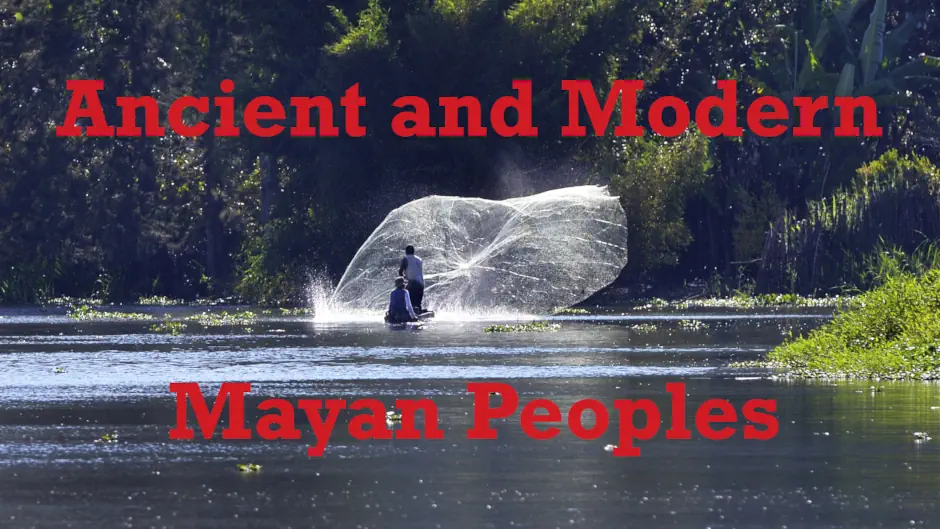The Indigenous Tzeltal People
Ethnonyms: Tseltal Countries inhabited: Mexico Language family: Mayan Language branch: Tzeltalan
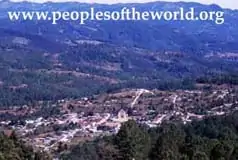
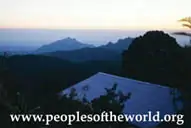 The Tzeltal are one of the many ancient Maya sub-groups that have survived to the present day. They live in the central highlands of
Chiapas State, Mexico. Linguistically, they are the cousins of the
Tzotzil. In fact, until the beginning of the Late-Postclassic period of Maya history (around 1200 CE), Tzeltal
and Tzotzil were not distinguishable languages.
The Tzeltal are one of the many ancient Maya sub-groups that have survived to the present day. They live in the central highlands of
Chiapas State, Mexico. Linguistically, they are the cousins of the
Tzotzil. In fact, until the beginning of the Late-Postclassic period of Maya history (around 1200 CE), Tzeltal
and Tzotzil were not distinguishable languages.
Today, almost a third of a million people speak Tzeltal as their first or second language. Bilingualism in Spanish is common among the Tzeltal.
Tzeltal society is organized today much as it has always been.
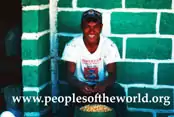 Cultural variation is evident among communities,
Cultural variation is evident among communities,
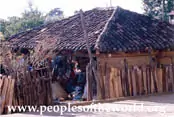 and can be observed
across, for example, dialect, dress and religious and social ritual. Still, the Tzeltal have many things in common.
Most Tzeltal communities
comprise mainly ethnolinguistic Tzeltal members who retain their indigenous language as their first language. Houses are
simple, mainly containing nuclear families whose life revolves around primarily subsistence agriculture (maize, beans and squash
being the staples), the commercial trade of livestock including chickens, pigs and sheep and crafts including weaving, sewing,
embroidery and pottery.
and can be observed
across, for example, dialect, dress and religious and social ritual. Still, the Tzeltal have many things in common.
Most Tzeltal communities
comprise mainly ethnolinguistic Tzeltal members who retain their indigenous language as their first language. Houses are
simple, mainly containing nuclear families whose life revolves around primarily subsistence agriculture (maize, beans and squash
being the staples), the commercial trade of livestock including chickens, pigs and sheep and crafts including weaving, sewing,
embroidery and pottery.
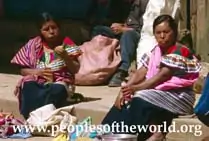
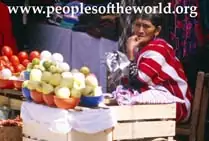 The Tzeltal have traditionally been able to produce some surplus food. They trade this surplus commercially by taking it to the town that is the
administrative center of their municipality.
In these photos women from the outlying parajes in the Municipio of Oxchuc are to be
seen in the weekly market — in the town of the same name — selling fruits and vegetables. Such markets rotate, usually on a weekly basis, so
that each municipio will have its opportunity for commercial trade on a regular basis. This trade, which as noted above extends beyond
mere surplus food, is the hub and the lifeblood of economic life in all Tzeltal communities.
The Tzeltal have traditionally been able to produce some surplus food. They trade this surplus commercially by taking it to the town that is the
administrative center of their municipality.
In these photos women from the outlying parajes in the Municipio of Oxchuc are to be
seen in the weekly market — in the town of the same name — selling fruits and vegetables. Such markets rotate, usually on a weekly basis, so
that each municipio will have its opportunity for commercial trade on a regular basis. This trade, which as noted above extends beyond
mere surplus food, is the hub and the lifeblood of economic life in all Tzeltal communities.
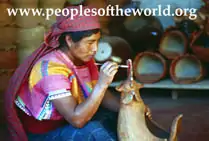
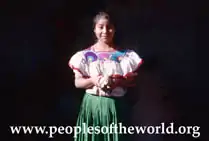 Amatenango del Valle is a much smaller municipality than Oxchuc, having
a population of less than 10,000 compared to Oxchuc's 35,000.
But it is probably more widely known both locally and internationally. The town of Amatenango del Valle provides a rare example of how the ancient Maya world has entered
modern times while both retaining tradition and embracing change. The women of this area have made pottery for as long as anyone can
remember. In times past this was for practical reasons and the pottery was made for everyday storage, cooking and eating.
Amatenango del Valle is a much smaller municipality than Oxchuc, having
a population of less than 10,000 compared to Oxchuc's 35,000.
But it is probably more widely known both locally and internationally. The town of Amatenango del Valle provides a rare example of how the ancient Maya world has entered
modern times while both retaining tradition and embracing change. The women of this area have made pottery for as long as anyone can
remember. In times past this was for practical reasons and the pottery was made for everyday storage, cooking and eating.
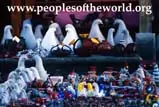
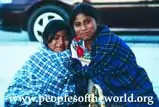 San Cristóbal de las Casas is one of Chiapas State's major cities. Recently the city and the surrounding area have seen a growth in
tourism. As a result the near-by town of Amatenango del Valle became
something of a tourist destination
largely because the pottery is still fired there using the pre-Columbian technique of placing the clay in an open fire instead of a kiln.
Capitalizing on the potential for commerce, many women in the town now also produce "art pottery" to sell
to tourists. This "art pottery" is slowly replacing the traditional items yet the open-fire production technique remains. The demand has grown so much that
a sideline industry has
developed for the young girls of the town. They make small trinkets — animalitos — which they also sell to visiting
tourists.
San Cristóbal de las Casas is one of Chiapas State's major cities. Recently the city and the surrounding area have seen a growth in
tourism. As a result the near-by town of Amatenango del Valle became
something of a tourist destination
largely because the pottery is still fired there using the pre-Columbian technique of placing the clay in an open fire instead of a kiln.
Capitalizing on the potential for commerce, many women in the town now also produce "art pottery" to sell
to tourists. This "art pottery" is slowly replacing the traditional items yet the open-fire production technique remains. The demand has grown so much that
a sideline industry has
developed for the young girls of the town. They make small trinkets — animalitos — which they also sell to visiting
tourists.
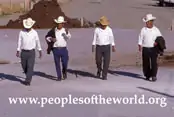
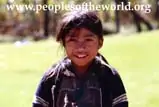 Another recent change in Tzeltal society is the increasing migration of adult men seeking non-traditional employment. As these men leave their
homelands they
meet unfamiliar challenges in the urban centers where they go to seek wage labor to supplement their family's income.
They are often exploited by their employers who can pay them less than they pay their Hispanic and ladino peers.
Another recent change in Tzeltal society is the increasing migration of adult men seeking non-traditional employment. As these men leave their
homelands they
meet unfamiliar challenges in the urban centers where they go to seek wage labor to supplement their family's income.
They are often exploited by their employers who can pay them less than they pay their Hispanic and ladino peers.
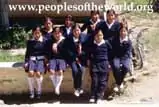 In contrast to their fathers' migration, many Tzeltal girl children stay at home and contribute
their own labor to their family's income.
In contrast to their fathers' migration, many Tzeltal girl children stay at home and contribute
their own labor to their family's income.
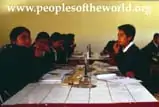 Driving by a small Tzeltal village we saw a common sight,
exemplified by this nine-year old girl who does not attend school but instead sells her
family's little surplus food at the side of the road.
The ancient Maya sacrificed their
children — literally — to their gods and in the modern world some are forced to sacrifice their children's education to their economic needs.
Driving by a small Tzeltal village we saw a common sight,
exemplified by this nine-year old girl who does not attend school but instead sells her
family's little surplus food at the side of the road.
The ancient Maya sacrificed their
children — literally — to their gods and in the modern world some are forced to sacrifice their children's education to their economic needs.
Many Tzeltal children do attend school. When we visited this one in Oxchuc, the teachers and students displayed pride in,
 and invited us to
photograph, their educational achievements.
These girls insisted on a group photo.
and invited us to
photograph, their educational achievements.
These girls insisted on a group photo.
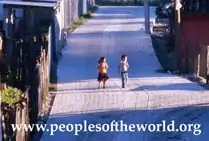 It is significant that adolescent girls
attend school in these communities. Just a
few generations ago they would be expected to marry around this age.
It is significant that adolescent girls
attend school in these communities. Just a
few generations ago they would be expected to marry around this age.
Some Tzeltal girls still marry and begin families before reaching full sexual maturity, but this is a part of traditional culture that is slowly disappearing from Tzeltal society. As with other Maya groups in Mesoamerica, the Tzeltal today face a critical time in their history. How they might change because of — or adapt to — modern influences will soon be in the hands of today's Tzeltal children.
Photography copyright © 1999 - 2026, Ray Waddington. All rights reserved. Text copyright © 1999 - 2026, The Peoples of the World Foundation. All rights reserved.

Waddington, R., (2008) The Indigenous Tzeltal People. The Peoples of the World Foundation. Retrieved January 7, 2026, from The Peoples of the World Foundation. <https://www.peoplesoftheworld.org/text?people=Tzeltal>
Web Links Los Tzeltales (en español) Die Tzeltal (auf Deutsch) Tzeltal-ii (in romana) Books Hunn, E. S., (1977) Tzeltal Folk Zoology: The Classification of Discontinuities in Nature. New York: Academic Press. Nash, J. C., (1970) In the Eyes of the Ancestors: Belief and Behavior in a Maya Community. New Haven: Yale University Press. Villa Rojas, A., (1969) "The Tzeltal." In R. Wauchope (Ed.), Handbook of Middle American Indians. pp. 195-225. Austin: University of Texas Press.
